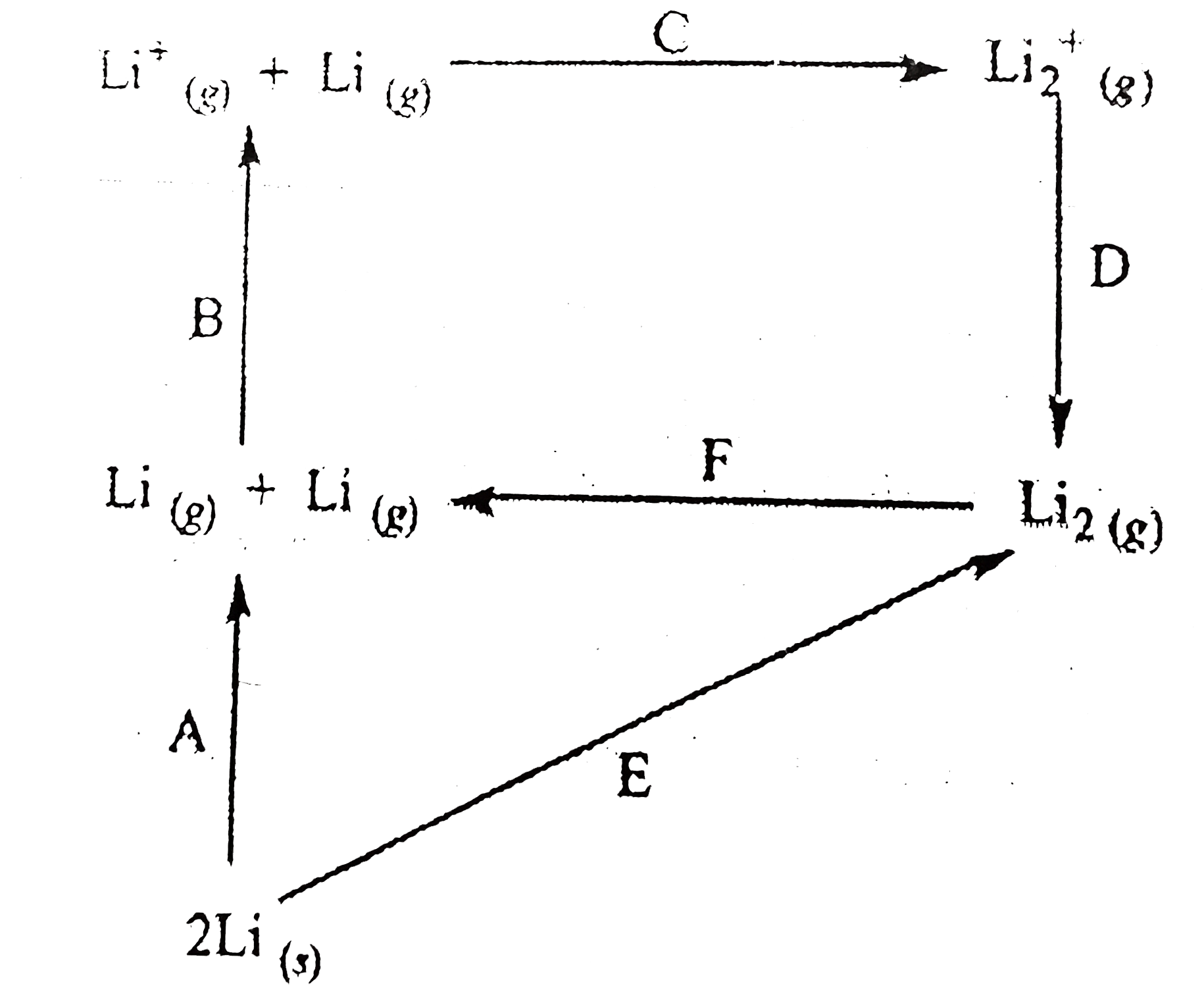Dilithium is crucial to the propulsion system of some starships. Dilithium is fomred by the adhesion of two lithium atoms in the gas phase:
Li(g)+Li(g)→Li2(g)
The enthalpy of formation of dilithium is not easily measurable by direct means. However, th following thermochemicalparameters are known.
ΔH∘f of Lig=150kJ/mol
IE of Lig=5eV/atom[1eV/atom=100kJ/mol]
BE of Li+(g)=130kJ/mol
IE of Li2(g)=5eV/molecule
[IE= ionisation energy] [BE= bond energy]
Q. What is bond energy of Li2(g)?
−230kJ/mol
230kJ/mol
170kJ/mol
130kJ/mol
The correct Answer is:B

We can construct a thermochemical cycle as shown in the figure, where the known quantities are
A=2×ΔH∘f of Li(g)=300kJ/mol
B=IE of Li(g)=500kJ/mol
C=−IE of Li+2=−130kJ/mol
D=−IE of Li2(g)=−500kJ/mol
and the unknowns are using hess's law.
ΔH∘f of Li2(g)=E=A+B+C+D=170kJ/mol
Similar Questions
Find bond enthalpy of C=O (in kJ/mol) using following information :
ΔHatomisation[C(s)]=700 kJ/mol
ΔHf[CO2(g)]=−400 kJ/mol
BEo=o=500 kJ/mol
Resonance energy of CO2=−150 kJ/molView SolutionThe energy needed for the following process is
Li(g)→Li3+(g)+3e−
If the first ionization energy of lithium is 520 kJ mol−1, calculate the second ionization energy of lithium, that is the energy required for the process.
Li+(g)→Li2+(g)+e−View Solution
Knowledge Check
- Question 1 - Select One
Dilithium is crucial to the propulsion system of some starships. Dilithium is fomred by the adhesion of two lithium atoms in the gas phase:
Li(g)+Li(g)→Li2(g)
The enthalpy of formation of dilithium is not easily measurable by direct means. However, th following thermochemicalparameters are known.
ΔH∘f of Lig=150kJ/mol
IE of Lig=5eV/atom[1eV/atom=100kJ/mol]
BE of Li+(g)=130kJ/mol
IE of Li2(g)=5eV/molecule
[IE= ionisation energy] [BE= bond energy]
Q. What is ΔH∘f of Li2(g)?A130kJ/molB170kJ/molC270kJ/molD−270kJ/mol - Question 2 - Select One
The standard enthalpy of formation of ammonia gas is
Given: N2H4(g)+H2(g)→2NH3(g),ΔH∘r=−40kJ/mol
ΔH∘f[N2H4(g)]=−120kJ/molA−60B−180C40D−80 - Question 3 - Select One or More
Lithium metal reacts with nitrogen gas to produce a white solid Lithium nitride (LiN) according to the reaction :
6Li(s)+N2(s)→2Li3N(s) if 8.4 g of Li is taken initially with excess of N2(g), then (Atomic weight of Li=7)AVolume of nitrogen gas consumed at STP is 4.54 LBTotal mass of the product obtained is 14 gCTotal number of atoms obtained in the prouduct is 1.6NADLithium and nitrogen combine in ratio 3:2 : by mass.
Calculate the energy change in kilojoules per mole when lithium atoms lose an electron to bromine atoms to form isolated Li and Br- ions. [The Ei for Li(g) is 520 kJ/mol; the Eea for Br(g) is -325 kJ/mol.]
View SolutionThe first ionisation potential of Li is 5.4 e V and the electron affinity of Cl is 3.6 eV . Calculate ΔH in kcal mol−1 for the reaction
Li(g)+Cl(g)→Li++Cl−
Carried out at such low pressures that resulting ions do not combine with each other.View Solutionthe heat evolved in physisorption lies in the range (in kJ/mol) of :
View Solution4Li(s)+O2(g)→2Li2O(s)
At 25∘C,ΔH for this reaction is -598.8 kilo joules per mole of Li should be reacted with excess O2(g) in order to relaase 150 Kj?View SolutionFor the reaction
N2H4(g)→N2H2(g)+H2(g),
ΔH∘reaction=109KJ/mol
∈N−N=163KJ/mol
∈N−H=391KJ/mol
∈H−H=KJ/mol
then ,then bond dissocition energy of N=N is:View Solution

